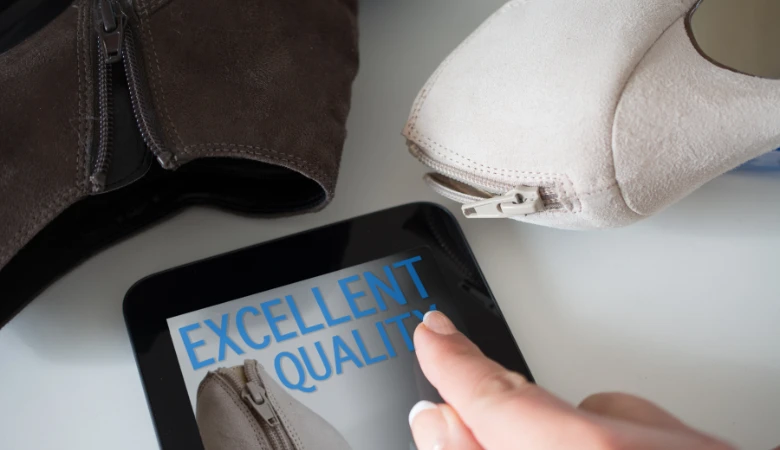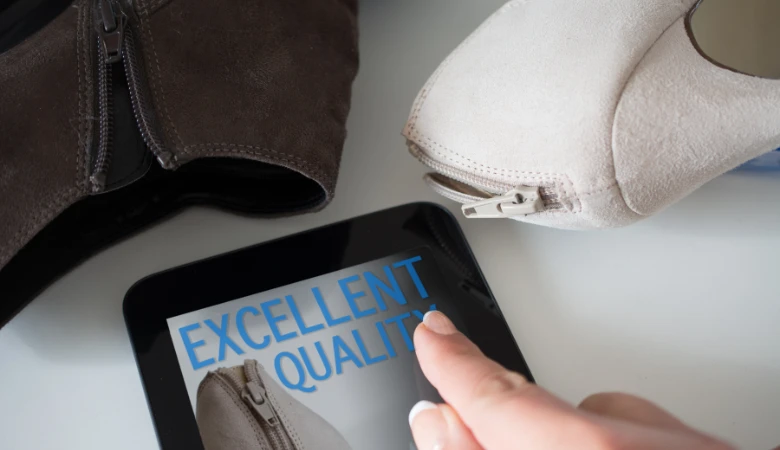
In 2025, you'll notice significant differences between china shoes quality control and international practices. China often focuses on high production efficiency, which sometimes compromises the consistency of quality control. On the other hand, international practices emphasize stringent regulations and advanced testing technologies to ensure product reliability. These disparities affect manufacturers and consumers alike. For manufacturers, inconsistent standards create challenges in global markets. As a consumer, you might question the durability or safety of products. Understanding these differences helps you make informed decisions in today's globalized footwear market.

China Shoes Quality Control Standards
Regulatory Frameworks in China
China has developed its own regulatory frameworks to oversee footwear manufacturing. These frameworks aim to ensure that products meet basic safety and performance requirements. You'll find that the government sets specific standards for materials, durability, and environmental impact. These standards are designed to align with the country’s focus on mass production while maintaining acceptable levels of quality.
However, the enforcement of these regulations often varies. Local authorities may interpret the rules differently, leading to inconsistencies. This can create challenges for manufacturers trying to meet both domestic and international expectations. Despite these hurdles, China continues to refine its regulatory systems to compete in the global footwear market.
Testing and Inspection Processes
In China, testing and inspection processes play a crucial role in maintaining product quality. Factories conduct tests to evaluate the durability, flexibility, and safety of footwear. These tests often include physical stress tests, chemical analysis, and wear-and-tear simulations. Inspection teams also check for defects in materials and construction.
You might notice that these processes are sometimes less rigorous compared to international practices. Many factories prioritize speed and cost-efficiency, which can affect the thoroughness of inspections. Even so, advancements in technology are helping to improve the accuracy and reliability of these tests.
Challenges in Implementation
Implementing quality control measures in China's footwear industry comes with unique challenges. High production volumes can make it difficult to maintain consistent standards. Some manufacturers may cut corners to reduce costs, which impacts the overall quality of the products. Additionally, the lack of uniform enforcement across regions creates disparities in compliance.
You, as a consumer, might encounter products that vary in quality depending on where they were made. For manufacturers, these challenges highlight the importance of adopting stricter quality control measures. Aligning with international standards could help address these issues and build trust with global consumers.
International Quality Control Standards for Footwear
Key Standards (ISO, ASTM, etc.)
When it comes to footwear, international organizations set clear benchmarks to ensure quality and safety. You'll often hear about ISO (International Organization for Standardization) and ASTM (American Society for Testing and Materials). These organizations create standards that guide manufacturers in producing reliable and durable shoes. For example, ISO standards cover areas like material strength, slip resistance, and environmental impact. ASTM focuses on testing methods, ensuring that shoes meet specific performance criteria. By following these standards, manufacturers can produce footwear that meets global expectations.
Global Testing and Inspection Processes
Testing and inspection processes play a vital role in maintaining footwear quality worldwide. You’ll find that global practices emphasize precision and thoroughness. Laboratories use advanced equipment to test shoes for durability, flexibility, and safety. For instance, machines simulate walking conditions to measure wear and tear. Chemical tests ensure materials are non-toxic and environmentally friendly. Inspectors also examine every detail, from stitching to sole attachment, to ensure consistency. These processes help you trust that the shoes you buy meet high-quality standards.
Strengths in Enforcement
One of the biggest advantages of international quality control lies in enforcement. Regulatory bodies actively monitor compliance, ensuring manufacturers follow the rules. You'll notice that penalties for non-compliance are strict, which motivates companies to maintain high standards. Regular audits and certifications also keep manufacturers accountable. This strong enforcement builds consumer trust and ensures that the footwear you purchase is safe, durable, and worth the investment.
Comparing China Shoes Quality Control with International Practices
Differences in Regulatory Stringency
When you compare China's shoe quality control with international standards, the differences in regulatory stringency stand out. China's regulations focus on meeting basic safety and performance benchmarks, which align with its emphasis on mass production. However, international standards, such as those set by ISO and ASTM, demand higher levels of compliance and authenticity. These standards require manufacturers to meet strict criteria for product quality, durability, and environmental impact.
In China, enforcement varies across regions. Some local authorities interpret rules differently, which creates inconsistencies in compliance. This can affect the reliability of footwear produced by sneaker suppliers in China. On the other hand, international practices rely on uniform enforcement, ensuring that manufacturers adhere to the same rules regardless of location. You’ll find that this consistency builds trust among consumers and strengthens the global reputation of footwear brands.
Variations in Testing Technology
Testing technology plays a crucial role in assessing product quality. In China, factories often use basic testing methods to evaluate footwear durability, flexibility, and safety. These methods prioritize speed and cost-efficiency, which can sometimes compromise the accuracy of quality assessment. For example, some sneaker suppliers in China may rely on manual inspections rather than advanced machinery.
International practices, however, leverage cutting-edge technology for quality assessment. Laboratories use automated machines to simulate real-world conditions, such as walking or running, to test the durability of top-quality sneakers. Chemical analysis ensures that materials are non-toxic and environmentally friendly. These advanced methods provide more precise results, helping manufacturers meet international standards and maintain compliance and authenticity.
Impact on Top-Quality Sneakers and Consumer Trust
The differences in regulatory stringency and testing technology directly impact the production of top-quality sneakers. In China, the focus on high-volume manufacturing can sometimes lead to variations in product quality. As a consumer, you might notice that sneakers from different suppliers vary in durability or comfort. This inconsistency can affect your trust in the brand.
International practices prioritize consistency and reliability. Manufacturers who follow these standards produce footwear that meets global expectations for quality and safety. This builds consumer trust and enhances the reputation of the brand. For sneaker suppliers in China, aligning with international standards offers a clear advantage. It helps them compete in global markets and ensures that their products meet the high expectations of consumers like you.
Tip: When shopping for sneakers, look for certifications or labels that indicate compliance with international standards. This ensures you’re investing in footwear that meets rigorous quality assessment criteria.
Implications for Sneaker Suppliers in China and Global Manufacturers
Challenges for Sneaker Suppliers in China
You face several challenges as a sneaker supplier in China. The global demand for sneakers continues to grow, but meeting international compliance and authenticity requirements remains a hurdle. Many factories prioritize high production volumes, which can compromise product quality. This focus on quantity over quality often leads to inconsistencies in footwear exports.
Regional differences in regulation enforcement further complicate the situation. Some areas in China interpret compliance standards differently, making it difficult for you to maintain uniformity in product quality. Additionally, the reliance on basic testing methods and manual inspections can limit your ability to meet the expectations of global markets.
Material sourcing also presents a challenge. You must ensure that raw materials meet both domestic and international standards. However, sourcing high-quality materials often increases costs, which can affect your competitiveness. These challenges highlight the importance of adopting advanced practices to improve your supplier reputation and compete in the export industry.
TradeAider: A Leading Force in Quality Control
In the competitive landscape of the global footwear market, selecting a reliable and efficient inspection and QA service provider is crucial. TradeAider emerges as a distinguished player, driven by visionary goals and a mission to revolutionize quality control. Our core strengths are rooted in the founder’s unwavering dedication and extensive experience in global trade and manufacturing. We are backed by a vast network of over 80,000 quality control specialists worldwide, strategically positioned throughout the entire production cycle. This extensive network, combined with the innovative TradeAider App, ensures seamless and successful quality assurance for every service order placed by our clients. We take pride in being a part of Amazon’s SPN for quality control, standing alongside industry leaders.
What Sets TradeAider Apart
TradeAider distinguishes itself from traditional inspection firms through our commitment to not only offering competitive pricing but also delivering unmatched efficiency and transparency. By leveraging cutting-edge digital tools, we provide our esteemed clients with the ability to monitor the entire inspection process in real-time via the TradeAider Web App. This level of transparency ensures that our clients are always informed and in control.
Moreover, we go the extra mile to ensure client satisfaction. TradeAider offers a Free Sticker-Attaching Service, guaranteeing that only products that meet the highest quality standards reach our clients. We also have a robust safeguard in place, backed by a reliable "refund commitment." This commitment instills trust from the very start, ensuring that our clients feel confident in their decision to partner with us.
Supporting Global Standards and Local Manufacturers
TradeAider is dedicated to helping manufacturers navigate the challenges of meeting international quality standards. Our global network and innovative tools are designed to assist manufacturers in enhancing their quality control processes, thereby building trust with consumers and strengthening their position in the global market. By aligning with TradeAider, manufacturers can leverage our expertise to overcome regional enforcement disparities and ensure consistent compliance with international benchmarks.
Benefits of Aligning with International Standards
Aligning with international standards offers you significant advantages. By meeting global benchmarks, you can ensure that your sneakers meet the expectations of consumers worldwide. This alignment not only improves product quality but also enhances your credibility in the global market.
Compliance with international standards allows you to access advanced testing technologies. These technologies help you conduct pre-shipment inspections that ensure your sneakers meet durability and safety requirements. This reduces the risk of returns or complaints, saving you time and resources.
Adopting international standards also strengthens your position in the export industry. It enables you to compete with suppliers from other countries, such as those sourcing from Vietnam. By focusing on compliance and authenticity, you can build trust with international buyers and expand your market reach.
Consumer Expectations for Quality in 2025
In 2025, consumers expect high-quality products that combine durability, comfort, and style. As a sneaker supplier, you must prioritize these factors to meet their demands. Consumers also value transparency in manufacturing processes. They want to know that the sneakers they purchase are made using ethical practices and sustainable materials.
You’ll find that sourcing top-quality sneakers requires a focus on advanced manufacturing techniques and rigorous quality control measures. Consumers are more likely to trust brands that adhere to international standards and provide certifications for their products. Meeting these expectations not only enhances your reputation but also ensures long-term success in the competitive footwear market.
Note: Staying ahead in the global market requires continuous improvement. Invest in advanced testing technologies and sustainable material sourcing to meet the evolving demands of consumers.
You’ve seen how China’s focus on mass production contrasts with the stringent standards of international practices. These differences affect manufacturers by creating challenges in global markets and impact you as a consumer by influencing product reliability.
• Key Implications:
◦ Manufacturers in China face hurdles in meeting global expectations.
◦ Consumers demand consistent quality and ethical production.
Takeaway: Adopting international standards ensures better sneakers, builds trust, and strengthens global competitiveness.
FAQ
What are the main differences between China’s and international shoe quality standards?
China focuses on mass production with basic safety benchmarks. International standards, like ISO and ASTM, demand stricter compliance for durability, safety, and environmental impact. These global standards ensure consistent quality, while China’s enforcement varies by region.
Why do international practices use advanced testing technologies?
Advanced technologies provide precise results. Machines simulate real-world conditions, like walking or running, to test durability. Chemical tests ensure materials are safe and eco-friendly. These methods help manufacturers meet global expectations and build consumer trust.
How can Chinese sneaker suppliers benefit from aligning with international standards?
Aligning with global standards improves product quality and credibility. It allows access to advanced testing tools and ensures compliance with international buyers’ expectations. This alignment helps you compete globally and reduces risks like returns or complaints.
What should you look for when buying sneakers in 2025?
Check for certifications indicating compliance with international standards. Look for durability, comfort, and ethical manufacturing practices. Transparency in sourcing and sustainable materials also matter. These factors ensure you invest in high-quality footwear.
How do consumer expectations influence sneaker manufacturing?
Consumers demand durable, stylish, and ethically made sneakers. They value transparency and sustainability. Manufacturers must adopt advanced techniques and rigorous quality control to meet these expectations. This focus builds trust and ensures long-term success in the competitive market.
Tip: Always verify product certifications and labels to ensure your sneakers meet global quality standards.
Grow your business with TradeAider Service
Click the button below to directly enter the TradeAider Service System. The simple steps from booking and payment to receiving reports are easy to operate.

.png)

